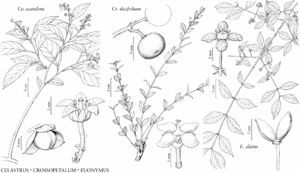Euonymus
Sp. Pl. 1: 197. 1753.
| Taxon | Illustrator ⠉ | |
|---|---|---|
 | Crossopetalum ilicifolium Euonymus alatus Celastrus scandens |
Shrubs, trees, or vines, climbing by adventitious-roots. Branchlets terete or 4-angled. Leaves deciduous or persistent, opposite; stipules present; petiole present; blade margins entire or toothed; venation pinnate. Inflorescences terminal or axillary, cymes. Flowers bisexual, radially symmetric; perianth and androecium hypogynous; hypanthium absent; sepals 4–5, distinct; petals 4–5, white, green, yellow, red, or purple; nectary intrastaminal, annular, fleshy; stamens 4–5, adnate to nectary margin; staminodes 0; pistil 4–5-carpellate; ovary superior, 4–5-locular, placentation axile; style 1; stigma 1; ovules 2 per locule. Fruits capsules, (1–) 2–5-locular, globose, subglobose, or obovoid, unlobed or 2–5-lobed, apex not beaked. Seeds 2 per locule, ellipsoid, ovoid, or subglobose, not winged; aril yellow, orange, or red, completely surrounding seed. x = 16.
Distribution
North America, Mexico, West Indies, Central America, Europe, e, se Asia, Africa, tropics and subtropics
Discussion
Species ca. 140 (7 in the flora).
Several cultivated species of Euonymus, all native to eastern Asia, are established locally in the flora area and, although apparently not naturalized, should be watched for invasive tendencies. Two of these, E. hamiltonianus Wallich, reported from Illinois, Indiana, and Michigan, and E. maackii Ruprecht (= E. bungeanus Maximowicz), reported from Colorado, Florida, Georgia, Illinois, and South Carolina, are similar to each other and to E. europaeus, from which they both differ by having purple (versus white) anthers. In addition, E. hamiltonianus can be distinguished by its red (versus orange or yellow) arils, and E. maackii by its leaf blades with smooth (versus rough) surfaces. Euonymus japonicus Thunberg, reported from Indiana, Louisiana, Mississippi, North Carolina, and Virginia, is similar to E. fortunei but is a shrub with erect stems that never produce adventitious roots. Euonymus phellomanus Loesener, reported from Connecticut and Massachusetts, has corky winged branches like E. alatus, but has larger leaves (6–10 × 2–3 cm) and yellow-brown to red-brown, four-angled capsules.
Selected References
Lower Taxa
Key
| 1 | Vines, climbing by adventitious roots; leaves persistent. | Euonymus fortunei |
| 1 | Shrubs or trees, creeping, arching, or erect; leaves deciduous. | > 2 |
| 2 | Young branches becoming corky winged; capsules deeply lobed to base or only 1 lobe developing, lobes nearly distinct. | Euonymus alatus |
| 2 | Young branches not corky winged; capsules unlobed to deeply lobed, rarely only 1 lobe developing, lobes clearly connate. | > 3 |
| 3 | Sepals, petals, and stamens 4; young branches terete. | > 4 |
| 4 | Petals dark purple, 1.5–2 mm; inflorescences 7–20-flowered; capsules 11–13 × 15–17 mm; seeds 5–7 mm, aril red. | Euonymus atropurpureus |
| 4 | Petals yellow or white, 3–4 mm; inflorescences 1–7(–15)-flowered; capsules 8–10 × 12–15 mm; seeds 7–8 mm, aril yellow or orange. | Euonymus europaeus |
| 3 | Sepals, petals, and stamens 5; young branches 4-angled. | > 5 |
| 5 | Capsules smooth, moderately 3(–5) lobed; petals brownish purple, 3–6.5 mm; seeds 6–8 mm. | Euonymus occidentalis |
| 5 | Capsules spiny, unlobed or very shallowly 4–5-lobed; petals pale green, often suffused with purple, 2–3 mm; seeds 4.5–5.5 mm. | > 6 |
| 6 | Stems erect or arching, not rooting at nodes; petioles 1–3 mm; leaf blades oval to lanceolate. | Euonymus americanus |
| 6 | Stems creeping, rooting at nodes; petioles 3–5 mm; leaf blades obovate. | Euonymus obovatus |